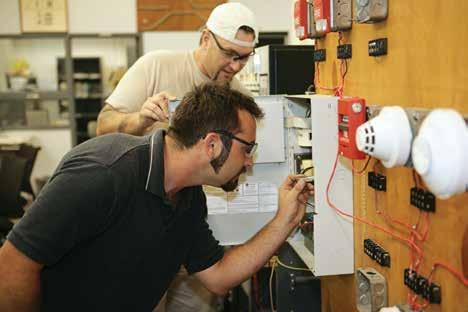
9 minute read
When fires cause storms
PHOTO: CHRISTINE HARPER, DBCA, WA
New technology is now available that predicts fire-generated thunderstorms, prompted by a sharp increase in the number of these storms and associated extreme fire events such as the devastating bushfires they caused in the 2019-20 fire season.
Above: Firegenerated thunderstorm forming during Lake King fire in WA, Februar y 2020.
BY BETHANY PATCH
Bushfire and Natural Hazards CRC
ire-generated thunderstorms, sometimes called
Fpyrocumulonimbus clouds or pyroCbs, are ferocious weather systems that can exacerbate the damage already caused by the bushfires that create them. While they are only just beginning to be understood, research by the Bushfire and Natural Hazards CRC is helping us measure and predict fire-generated thunderstorms more effectively. This research aims to improve warning systems and assist agencies with analysis and forecasting.
Dr Kevin Tor y, Senior Research Scientist at the Bureau of Meteorology (BOM), is one of the researchers taking part in the CRC’s Improved predictions of severe weather to reduce community impact project, which is exploring firegenerated thunderstorm prediction. The team’s research has developed a new tool that is helping fire agencies and BOM weather forecasters to predict when these dangerous storms might occur, so that fire agencies can warn communities and firefighters.
Dr Tor y explains that fire-generated thunderstorms have much in common with conventional thunderstorms—both require warm humid air to be lifted into an unstable layer above. However, far less is known about the former, including why they have become so much more common recently.
“ We are getting better at identifying these storms with improved satellite coverage, but this can’t explain the dramatic increase in numbers of events we’ve seen globally in the last few years,” Dr Tor y said.
According to Rick McRae, who
has been studying fire-generated Atmospheric Research and Satellite understanding how large and intense a thunderstorms for almost 40 years, Obser vations at Sorbonne University in fire would need to become for a specific Australia has entered an era of violent France recently reported that the smoke atmospheric environment, and whether pyro-convection since the first closely was so thick that it acted like a planetar y or not you have the right mix of fuels, studied storm in Berringa, Victoria, in 1995. shade, blocking the sun and briefly terrain, local winds and complex fire
“PyroCbs are a ver y strong signal of creating a cooling effect—similar to a behaviours that would allow the fire to how badly climate change is impacting moderate volcanic eruption. become large and intense enough.” the globe,” he said. Of course, not all extreme fires go According to Dr Tor y, a basic
“ With normal fires, if you know the on to produce intense new weather understanding of three things is needed fuel, the weather and the terrain, then events, but conditions can become ver y in order to understand how large and you know what the fire will be doing, with ferocious and significantly destructive intense a fire needs to be to create a a few exceptions. A blow-up fire event when they do, often resulting in far- fire-generated thunderstorm: displays dynamic fire behaviour—they carried embers or the creation of entirely 1. The height smoke plumes rise for any are basically a different species of fire. new fires from lightning strikes. given fire intensity and wind speed. They develop feedback processes.” This kind of firestorm occurs when The greater the fire intensity, the taller
Mr McRae began searching for the hot gases in the smoke plume rise and more vigorous the smoke plume, previous instances of fire-generated high enough to begin interacting with the whereas the stronger the wind, the thunderstorms in 2003. Prior to atmosphere, causing clouds to form and more the plume is blown over and 2001, there were two known and two inducing a powerful local thunderstorm. spreads out downwind. suspected events in Australia. There are With the increase in these firestorms, 2. The height to which the smoke plume now 118 on the list—including 37 during it is becoming easier to identify and must rise before it cools enough for last season’s Black Summer bushfires, predict them with the help of new cloud to start forming. This requires which raged through south-eastern technologies. an understanding of how the NSW and eastern Victoria. This made Dr Tor y explains that, in some ways, temperature and humidity changes the Black Summer bushfires the most the formation of these storms is ver y with height in the smoke plume. intense series of pyro-convective events simple to understand. The analysis of fire 3. The instability of the atmosphere. This ever recorded. and plumes is more complicated. determines how buoyant and strong
The smoke from fires near “All you need is an enormously hot the updrafts in the cloudy plume need Mallacoota, Victoria, eventually fire in an unstable atmosphere and to be for a thunderstorm to develop. reached a height of 35 kilometres, a fire-generated thunderstorm will A series of CRC studies has helped 346539 - Redmen Ad 130x185mm 29.01.21.pdf 1 1/29/21 9:26 AMand is now being studied worldwide. develop,” he said. analyse plume behaviour more Sergey Khaykin at the Laborator y of “The real complexity is in accurately. Building on this research,

LET’S JOIN FORCES!
What could your company achieve with more financial support?

Have you considered, a supportive business partner to share the load?
We are looking to join with professional fire protection and training companies through mergers or acquisitions. We understand the mindset of small – medium business and can provide the needed support to achieve corporate and personal Goals.

Lets have a chat about your needs and how we can assist.
Our company valuations are very generous and well above market norms.
Why not??? Call now for an open preliminary discussion!!!
Please call or email
Mike Donegan 0412 342 474 or thanksmate@redadair.com.au



Dr Tor y’s team at the BOM has been focusing specifically on the first point, in order to understand how large and intense the fire would need to be to produce one of these fierce storms.
“ We focus on the atmosphere, which is much more predictable than fire. If we know how large and intense a fire will become, and how large and intense a fire needs to be for a fire-generated thunderstorm to form, we can, in theor y, predict them. However, predicting the future fire size and intensity remains an enormous challenge,” Dr Tor y said.
His work has culminated in the development of a diagnostic tool that can determine when the atmosphere is conducive to both deep plume development and large, hot fires, which is assisting fire agencies and the BOM with accurate and quick predictions that inform subsequent warnings.
The Pyrocumulonimbus Firepower Threshold (PFT) is new technology that measures the threshold or minimum firepower required for fire-generated thunderstorms to form, essentially assessing the atmospheric potential to support the development of a fire sufficiently large and intense for one of these storms to develop. It is proving to be highly predictive.
“ We were surprised how well the tool seems to work. We seem to have identified a handful of key ingredients, and the way they fit together largely determines how favourable the atmosphere is for fire-generated thunderstorm formation,” Dr Tor y said.
The research team began by using a computer-generated weather forecast to create contour maps of the PFT, then handed them out to a selection of fire weather forecasters and fire behaviour analysts.
“ We know that a fire-generated thunderstorm can be ver y hazardous, but we also know that many are quite benign,” said Dr Tor y.
“The PFT is great because it helps to pinpoint the threat timing and location.”
Within weeks, these maps were being used to predict the Black Summer firestorms. This allowed the researchers to practise using and refining the tool, identifying its strengths and weaknesses and making improvements.
Partnerships with fire and emergency ser vices and other government partners, coordinated through the CRC, have been essential in building and developing the tool. This has helped to make it easier to use, so that it can be actively applied when forecasters and analysts need it the most. The tool is now used by fire behaviour analysts within fire agencies and land management departments, as well as by BOM forecasters, who work closely with fire agencies advising on severe weather.
Jamie Molloy, a fire behaviour analyst and Program Manager of the Forest Protection Sur vey Program at the Victorian Department of Environment, Land, Water and Planning, explains just how helpful the PFT has been for his team when analysing fires.
“The Pyrocumulonimbus Firepower Threshold is a significant improvement in identifying fire-generated thunderstorm risk, including helping to flag other factors that should be looked at, such as mixed-layer windspeed,” Mr Molloy said.
“I review it ever y day that I am deployed as a fire behaviour analyst. It gives me a ver y quick heads-up on the potential, broad timing and location of fire-generated thunderstorms—if the chance of a storm is identified, it prompts further investigation of ignition potential, atmospheric instability and thus the likelihood of firestorms and community risk in those areas.”
In Western Australia, the tool has been used by the Department of Biodiversity, Conser vation and Attractions during the past two southern fire seasons. Brett Beecham, having worked in intelligence and predictions for the Department for the past ten years, reiterated how helpful the PFT was when assessing pyro-convection and the risk of extreme fires.
“The Pyrocumulonimbus Firepower Threshold provides one more piece of information about the potential for a fire to interact with the atmosphere around it, and I now use it in conjunction with other tools to gain a better insight into the risks of extreme fire behaviour,” he said.
“It provides vital information about the likelihood of extreme fire behaviour due to strong pyro-convection, and this ultimately leads to improved firefighter and community safety during a bushfire.”
The PFT is also being regularly used by NSW Rural Fire Ser vice fire analysts such as David Philp.
“From the perspective of a fire behaviour analyst for an incident management team, knowing the possible potential storm risk triggers the need for closer monitoring of the broader weather conditions to ensure appropriate storm warnings are issued, rather than waiting for specific warnings being issued through the Rural Fire Ser vice State Operations Centre,” he said.
The tool will continue to be improved and expanded as more evidence comes to hand. Dr Tor y and other scientists are racing to learn as much about firegenerated thunderstorms and other extreme weather systems as possible, knowing that a better understanding is essential to reducing preventable firerelated deaths.
“If we knew more about what makes fire-generated thunderstorms dangerous, we should be able to tailor some of the ingredients or adjust thresholds to better highlight dangerous events. More field studies—with ever y type of monitoring equipment we can think of – will help us better understand these events,” Dr Tor y said.
To learn more about this research, visit www.bnhcrc.com.au/research/ predictingsevereweather.










